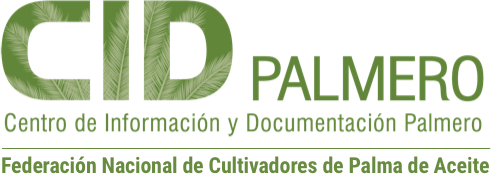Brechas de rendimiento en el cultivo de palma de aceite: una revisión cuantitativa de factores determinantes

Author
Woittiez, Lotte S.
van Wijk, Mark T.
Slingerland, Maja
van Noordwijk, Meine
Giller, Ken E.
Estadisticas
Publicación:
Revista Palmas; Vol. 39 Núm. 1 (2018); 16-68
0121-2923
Revista Palmas; Vol. 39 Núm. 1 (2018); 16-68
0121-2923
Abstract
Oil palm, currently the world’s main vegetable oil crop, is characterized by a large productivity and a long life span (≥ 25 years). Peak oil yields of 12 t ha/yr have been achieved in small plantations, and maximum theoretical yields as calculated with simulation models are 18.5 t oil ha/yr, yet average productivity worldwide has stagnated around 3 t oil ha/yr. Considering the threat of expansion into valuable rainforests, it is important that the factors underlying these existing yield gaps are understood and, where feasible, addressed. In this review, we present an overview of the available data on yield-determining, yield-limiting, and yield-reducing factors in oil palm; the effects of these factors on yield, as measured in case studies or calculated using computer models; and the underlying plant-physiological mechanisms. We distinguish four production levels: the potential, water-limited, nutrient-limited, and the actual yield. The potential yield over a plantation lifetime is determined by incoming photosynthetically active radiation (par), temperature, atmospheric CO2 concentration and planting material, assuming optimum plantation establishment, planting density (120-150 palms per hectares), canopy management (30-60 leaves depending on palm age), pollination, and harvesting. Water-limited yields in environments with water deficits > 400 mm/yr can be less than one-third of the potential yield, depending on additional factors such as temperature, wind speed, soil texture, and soil depth. Nutrient-limited yields of less than 50% of the potential yield have been recorded when nitrogen or potassium were not applied. Actual yields are influenced by yield-reducing factors such as unsuitable ground vegetation, pests, and diseases, and may be close to zero in case of severe infestations. Smallholders face particular constraints such as the use of counterfeit seed and insufficient fertilizer application. Closing yield gaps in existing plantations could increase global production by 15-20 Mt oil/yr, which would limit the drive for further area expansion at a global scale. To increase yields in existing and future plantations in a sustainable way, all production factors mentioned need to be understood and addressed. La palma de aceite, actualmente el principal cultivo oleaginoso del mundo, se caracteriza por su alta productividad y un prolongado ciclo de vida (≥ 25 años). Este cultivo ha alcanzado picos de rendimiento de 12 t aceite/ha/año en pequeñas plantaciones y su máximo rendimiento teórico (calculado mediante modelos de simulación) es de 18,5 t aceite/ha/año. No obstante, la productividad promedio se ha estancado en aproximadamente 3 t de aceite/ha/año. Considerando la posible expansión de este cultivo hacia zonas ocupadas por valiosos ecosistemas de bosque húmedo tropical, es importante comprender los factores que influyen en la generación de brechas de rendimiento con el fin de abordarlos eficientemente. En este artículo de revisión se presenta una visión general de los datos disponibles sobre los factores que determinan, limitan y reducen la productividad del cultivo; los efectos de dichos factores sobre el rendimiento del cultivo, de acuerdo con mediciones realizadas en estudios de caso o calculadas mediante modelos de computador; y de los mecanismos fisiológicos subyacentes a esta planta. Para ello, se identifican cuatro niveles de productividad: rendimiento potencial, rendimiento bajo condiciones de déficit hídrico, rendimiento con déficit nutricional y rendimiento real. El rendimiento potencial durante la vida útil del cultivo es determinado por la radiación fotosintéticamente activa (rfa), la temperatura, la concentración de CO2 atmosférico y el material de siembra (suponiendo condiciones óptimas en el establecimiento del cultivo), la densidad de siembra (120-150 palmas/ha), el manejo de la poda (30-60 hojas, dependiendo de la edad de la planta), la polinización de las inflorescencias y la eficiencia en la etapa de cosecha. Lo resultados de esta revisión indican que la productividad en entornos con déficit hídrico de > 400 mm/año puede ser menor a un tercio del rendimiento potencial, dependiendo de factores adicionales tales como la temperatura, la velocidad delviento y la textura y la profundidad de los suelos. Además, la literatura ha reportado disminuciones de 50 % en el rendimiento potencial del cultivo cuando no se realiza la aplicación de nitrógeno y/o potasio. Así mismo, se advierte que el rendimiento real del cultivo de palma se ve limitado por factores tales como la presencia de vegetación no apta para el cultivo, la incidencia de plagas y enfermedades, las cuales pueden reducir las cifras de productividad a cero en casos severos de afectación fitosanitaria. Adicionalmente, la literatura señala que los pequeños productores se enfrentan a limitantes particulares, tales como el uso de semillas falsificadas y problemas con el uso de fertilizantes. Se concluye de la información analizada que el cierre de las brechas de productividad en los cultivos ya establecidos podría incrementar la producción mundial a razón de 15-20 millones de toneladas de aceite por año, lo cual mitigaría la necesidad de ampliar el área sembrada a nivel mundial. Sin embargo, lograr incrementos en la productividad actual y futura bajo parámetros de sostenibilidad, supone la correcta comprensión y abordaje de todos los factores que determinan la eficiencia de este cultivo.
Oil palm, currently the world’s main vegetable oil crop, is characterized by a large productivity and a long life span (≥ 25 years). Peak oil yields of 12 t ha/yr have been achieved in small plantations, and maximum theoretical yields as calculated with simulation models are 18.5 t oil ha/yr, yet average productivity worldwide has stagnated around 3 t oil ha/yr. Considering the threat of expansion into valuable rainforests, it is important that the factors underlying these existing yield gaps are understood and, where feasible, addressed. In this review, we present an overview of the available data on yield-determining, yield-limiting, and yield-reducing factors in oil palm; the effects of these factors on yield, as measured in case studies or calculated using computer models; and the underlying plant-physiological mechanisms. We distinguish four production levels: the potential, water-limited, nutrient-limited, and the actual yield. The potential yield over a plantation lifetime is determined by incoming photosynthetically active radiation (par), temperature, atmospheric CO2 concentration and planting material, assuming optimum plantation establishment, planting density (120-150 palms per hectares), canopy management (30-60 leaves depending on palm age), pollination, and harvesting. Water-limited yields in environments with water deficits > 400 mm/yr can be less than one-third of the potential yield, depending on additional factors such as temperature, wind speed, soil texture, and soil depth. Nutrient-limited yields of less than 50% of the potential yield have been recorded when nitrogen or potassium were not applied. Actual yields are influenced by yield-reducing factors such as unsuitable ground vegetation, pests, and diseases, and may be close to zero in case of severe infestations. Smallholders face particular constraints such as the use of counterfeit seed and insufficient fertilizer application. Closing yield gaps in existing plantations could increase global production by 15-20 Mt oil/yr, which would limit the drive for further area expansion at a global scale. To increase yields in existing and future plantations in a sustainable way, all production factors mentioned need to be understood and addressed.


